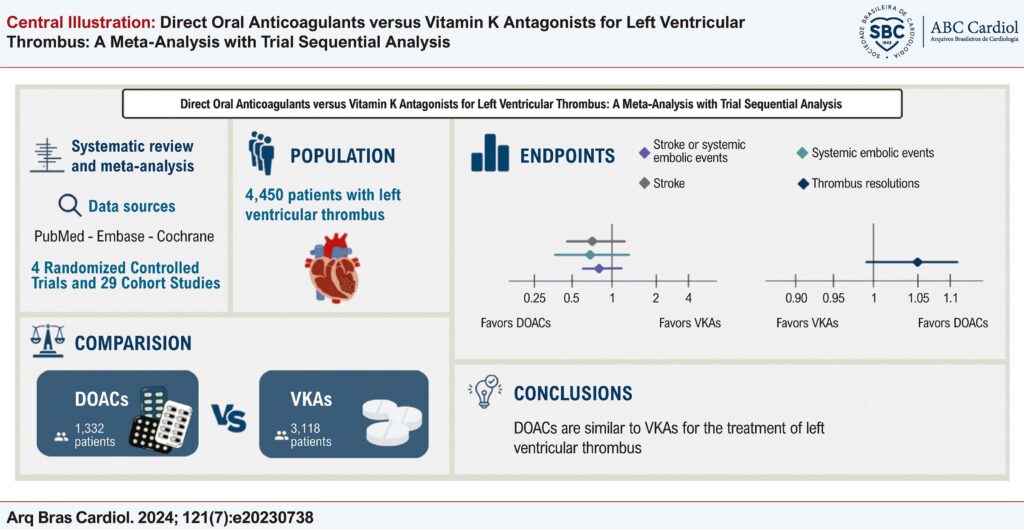Arq. Bras. Cardiol. 2024; 121(7): e20230738
Direct Oral Anticoagulants versus Vitamin K Antagonists for Left Ventricular Thrombus: A Meta-Analysis with Trial Sequential Analysis
This Original Article is referred by the Short Editorial "Advancing the Use of Direct Oral Anticoagulants in Left Ventricular Thrombus Management".
Abstract
Background
Vitamin K antagonists (VKAs) are the recommended first-line treatment for left ventricular thrombus (LVT); however, direct oral anticoagulants (DOACs) have been considered an alternative therapy.
Objectives
To evaluate the efficacy and safety of DOACs compared with VKAs therapy in patients with LVT.
Methods
PubMed, Embase, and Cochrane were systematically searched for randomized clinical trials or cohort studies that compared DOACs versus VKAs for LVT. Risk ratios (RRs) were computed for binary endpoints, with 95% confidence intervals (95% CIs). Statistical significance was defined as p value < 0.05.
Results
A total of 4 randomized clinical trials and 29 cohort studies were included, with 4,450 patients assigned to either DOACs or VKAs. There was no significant difference between groups for stroke or systemic embolic (SSE) events (RR 0.84; 95% CI 0.65 to 1.07; p = 0.157), stroke (RR 0.73; 95% CI 0.48 to 1.11; p = 0.140), systemic embolic (SE) events (RR 0.69; 95% CI 0.40 to 1.17; p = 0.166), thrombus resolution (RR 1.05; 95% CI 0.99 to 1.11; p = 0.077), any bleeding (RR 0.78; 95% CI 0.60 to 1.00; p = 0.054), clinically relevant bleeding (RR 0.69; 95% CI 0.46 to 1.03; p = 0.066), minor bleeding (RR 0.73; 95% CI 0.43 to 1.23; p = 0.234), major bleeding (RR 0.87; 95% CI 0.42 to 1.80; p = 0.705), and all-cause mortality (RR 1.05; 95% CI 0.79 to 1.39; p = 0.752). Compared with VKAs, rivaroxaban significantly reduced SSE events (RR 0.35; 95% CI 0.16 to 0.91; p = 0.029) and SE events (RR 0.39; 95% CI 0.16 to 0.95; p = 0.037).
Conclusions
DOACs had a similar rate of thromboembolic and hemorrhagic events, as well as thrombus resolution, compared to VKAs in the treatment of LVTs. Rivaroxaban therapy had a significant reduction in thromboembolic events, compared to VKAs.
Keywords: Factor Xa Inhibitors; Thrombosis; Warfarin
1,311

